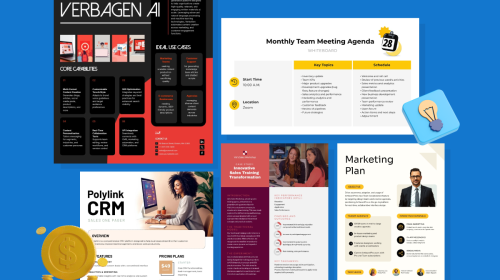
Interactive Content Marketing: Strategies, Examples & Tools


Most marketing content struggles to keep people engaged.
Static blogs, PDFs and infographics often get skimmed, with readers dropping off before they reach the most valuable information. In fact, industry benchmarks show that many pages get less than 1 minute, 31 seconds of reading time on average.
BuzzFeed cracked this code years ago. Their quizzes go viral and almost all users finish them. That’s proof that interactive content marketing works.
Research shows it can generate 1.5 times the engagement of static content.
For marketers, it’s also a way to collect first-party data and build a competitive edge with helpful, authoritative content that stands out.
In this guide, you will learn why interactive content works, see real-world examples from brands using it to dominate attention and get tools and prompts to build your own high-value assets.
Before you dive in, watch this video to discover how you can elevate your interactive content marketing efforts.
*Disclaimer: The comparisons and competitor ratings presented in this article are based on features available as of September 18, 2025. We conduct thorough research and draw on both first-hand experience and reputable sources to provide reliable insights. However, as tools and technologies evolve, we recommend readers verify details and consider additional research to ensure the information meets their specific needs.
Traditional marketing content like blog posts, infographics and PDFs are mostly static and passive. People just scroll through, skim a bit and forget it just as fast.
Interactive content breaks that cycle. It puts your audience in the driver’s seat. Instead of scrolling past, people get to do something. They can either click, swipe, calculate, answer or dig into more details.
The shift from passively watching to actively engaging is what makes interactive content memorable. Engagement time skyrockets, bounce rates drop and you collect real data on what people care about.
And it’s no longer optional. According to Forbes, the number of businesses using interactive content in their marketing strategies doubled from 2023 to 2024. Marketers have realized that if they want to cut through the noise, static content won’t cut it.
As James Wilkinson, Founder of Balance One Supplements Inc, noted:
"Interactive content is more than a marketing trend; it's a strategic differentiator. When I encounter interactive content online, I pay closer attention. If it's useful, I remember the brand long after."
Here’s a breakdown of the most effective types of interactive content and when to use them in your marketing efforts.
| Type of Interactive Content | Description | Best Use Case |
| Interactive Ebooks | Digital books with clickable navigation, embedded media and links. | Educating prospects while generating leads. |
| Polls & Surveys | Short questions to capture opinions or feedback instantly. | Collecting market insights, customer feedback or social engagement. |
| Quizzes & Assessments | Personalized Q&A experiences with tailored results. | Lead generation, product recommendations or audience learning. |
| Interactive Infographics | Visual storytelling with clickable or animated data points. | Simplifying complex stats or processes. |
| Calculators | Tools for personalized outputs (ROI, savings, cost). | Showing tangible value of your product/service. |
| Interactive Videos | Clickable or branching videos with embedded CTAs. | Demos, onboarding or customer training. |
| Interactive Presentations | Slides with hotspots, embedded media and navigation. | Sales pitches, internal reports or investor decks. |
| Gamified Content | Content with rewards, points or progress mechanics. | Training, onboarding or boosting campaign participation. |
| Interactive Reports | Dynamic reports with charts, filters and navigation. | Annual reports, impact reports or executive dashboards. |
| Interactive PDFs | Static PDFs upgraded with clickable links, embedded videos and forms. | Training manuals, guides and product brochures. |
| Interactive Checklists | Step-by-step, tickable task lists or planners. | Onboarding, project management or compliance workflows. |
| Interactive Data Visualizations | Real-time or clickable charts, graphs and comparisons. | Presenting performance data, trends or forecasts. |
| Interactive Tools (Maps & Dashboards) | User-driven maps, dashboards or scenario tools. | Showcasing geographic insights, product availability or analytics. |
| Social Media Graphics | Interactive carousels, polls or swipe-through posts. | Boosting brand awareness and engagement. |
| Interactive Emails | Emails with embedded surveys, polls, countdowns or carousels. | Increasing click-through and subscriber engagement. |
For a comprehensive breakdown of strategies and real-world examples, refer to our complete guide on interactive content.
Interactive marketing drives results; top brands are already using it at scale.
Here are a few great interactive content marketing examples to light your creative spark and open your minds to the possibilities.

Nespresso came up with the Coffee Profiler Quiz to make picking the right coffee blend way easier for customers. It’s more like chatting with a friendly barista than just scrolling through a product list. The quiz asks about your taste, how you brew your coffee and your daily habits before suggesting specific coffees and machines.
While it’s a fun and interactive quiz, it’s also a smart content marketing asset that addresses a big consideration-stage barrier: choice overload.
Instead of letting shoppers get lost in endless product pages or options, the profiler points them to a custom solution. Plus, Nespresso gathers useful data about preferences, which helps them personalize future campaigns and make them more effective.
Use Visme forms to build interactive, animated profiling quizzes and forms that collect user data and increase conversions by up to 2X. You can customize fields, add conditional logic and even incorporate 3D characters with entry/exit effects to match your brand style.
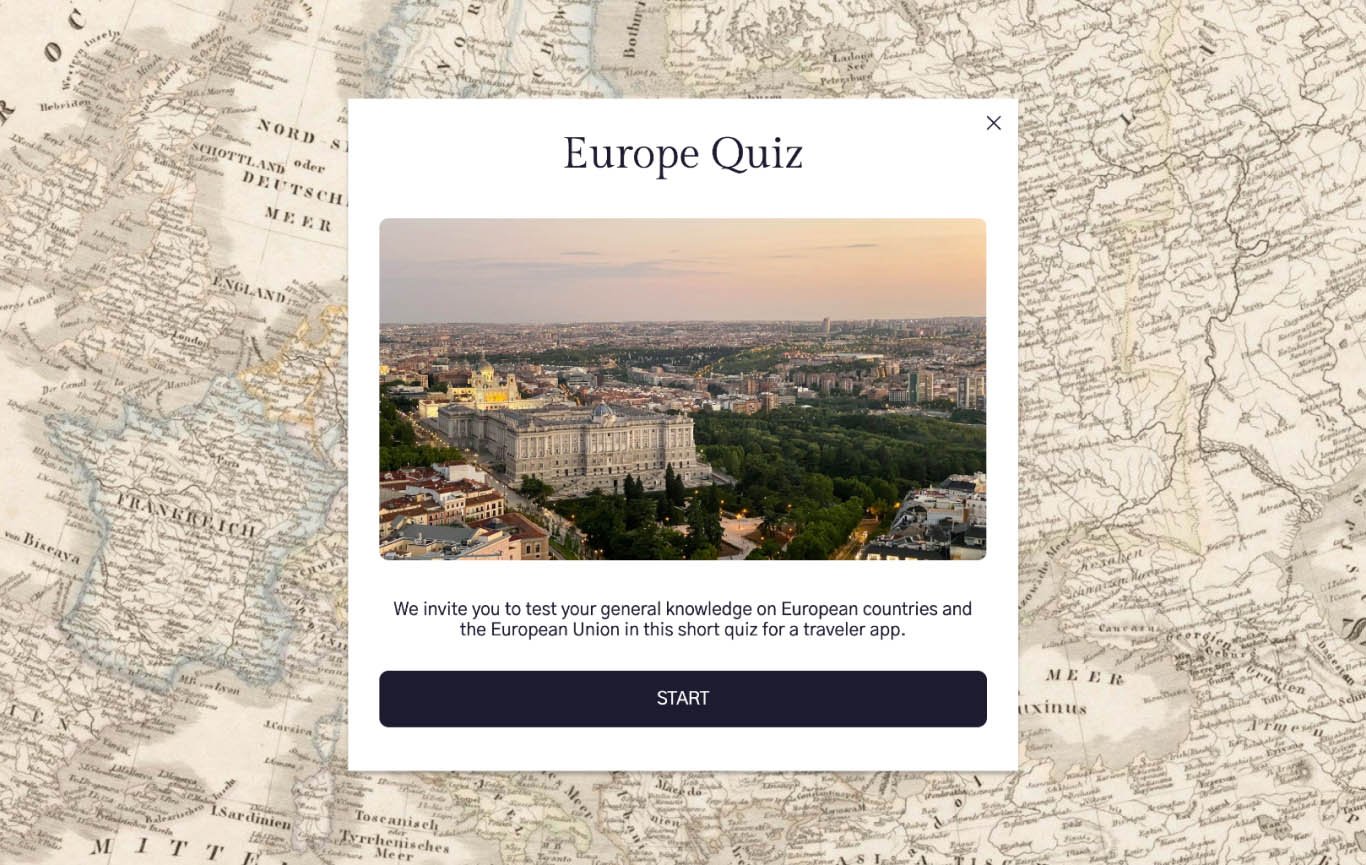
Publish the quiz as a shareable link, QR code or embed it directly on your website with auto-generated HTML.
“Create a 7-question profiler quiz that recommends the best [product/service] option based on user preferences.”

Source: IKEA
IKEA has long been known for its immersive catalogs.
But now they’ve taken experiential content marketing to the next level with their interactive online showrooms and AR app, IKEA Place.
Customers can easily browse through styled rooms online and click on hotspots to check out product details or add things right to their cart. On mobile, the AR app lets users see how furniture would look in their own space. This makes it super easy to go from feeling inspired to making a purchase.
These features aren’t just cool tech tricks. They’re essential parts of IKEA's interactive content marketing strategy that help customers discover products easily and make quicker decisions.
By blending interactivity, IKEA turns what could be a frustrating shopping experience into a smooth and confident journey that boosts online sales.
Use interactive content marketing tools like ThingLink or Visme hotspots to create experiential room tours.
With Visme, you can incorporate clickable popups, hover effects, animations, illustrations, special effects, videos and other interactive elements to guide shoppers through the experience.
Here’s an interactive presentation created in Visme
Made with Visme Presentation Maker
Take a look at this virtual experience center that IRISS made with Visme.
Share and publish as a live link or HTML5 file that can be embedded in a website or landing page. But if your interactive content is for training or e-learning purposes, you can download it as a SCORM or xAPI file and upload it to your learning management system.
Booking.com recently partnered with Amazon’s Brand Innovation Lab to launch Travel the Screen, one of the most compelling interactive content examples for the travel industry.
This interactive video experience was tied to the Amazon Original film The Idea of You.
As viewers watched scenes unfold, they could click on hotspots to explore real travel destinations and hotel options inspired by the story.
Instead of a passive ad, the video doubled as a booking pathway, turning curiosity about a location into a direct nudge to book a trip.

Between May 2 and June 10, the campaign reached 22.3 million unique users and drove positive brand impact for Booking.com. Booking.com saw a 10% increase in aided brand awareness and a 9% increase in brand opinion.

Why It Works: It collapses the gap between inspiration and action. By placing offers inside the content itself, Booking.com created a seamless flow from entertainment to purchase intent.

“We collaborated closely with Amazon Ads and Prime Video to create custom creative that felt like an extension of the content, not just an ad break,” Grieger says. “Our brand came through in a way that enhanced the story, helped fans go deeper, and made travel feel accessible and exciting. It’s not enough to just show up; we need to offer something meaningful. Interactive campaigns like this one invite audiences to explore, dream, and plan.” says Jenn Grieger, the Senior Manager of Marketing for brand media at Booking.com.
Use interactive content marketing software like Smartzer, Adventr or Mindstamp for dynamic video overlays that create clickable, shoppable moments inside your story.
AI Prompt: “Create an interactive video where viewers can click on hotspots to explore products or destinations featured in the story.”
Whether you're trying to educate early-stage leads, build trust during consideration or close the deal, there’s an interactive content format that fits. It also builds loyalty long after the first purchase.
The trick is knowing which type of content works best at each stage of the marketing funnel.
Let’s take a look at how different interactive content marketing formats fit into each phase.
At this stage, prospects are just beginning to research a problem or need. Your goal is to grab attention and spark curiosity, not push for a hard sell.
"Interactive content tends to be way more memorable. I still remember a travel company's trip builder that helped me learn about destinations in a really personal way, even years later." Leah Miller, Marketing Strategist, Versys Media,
Use these TOFU content types:
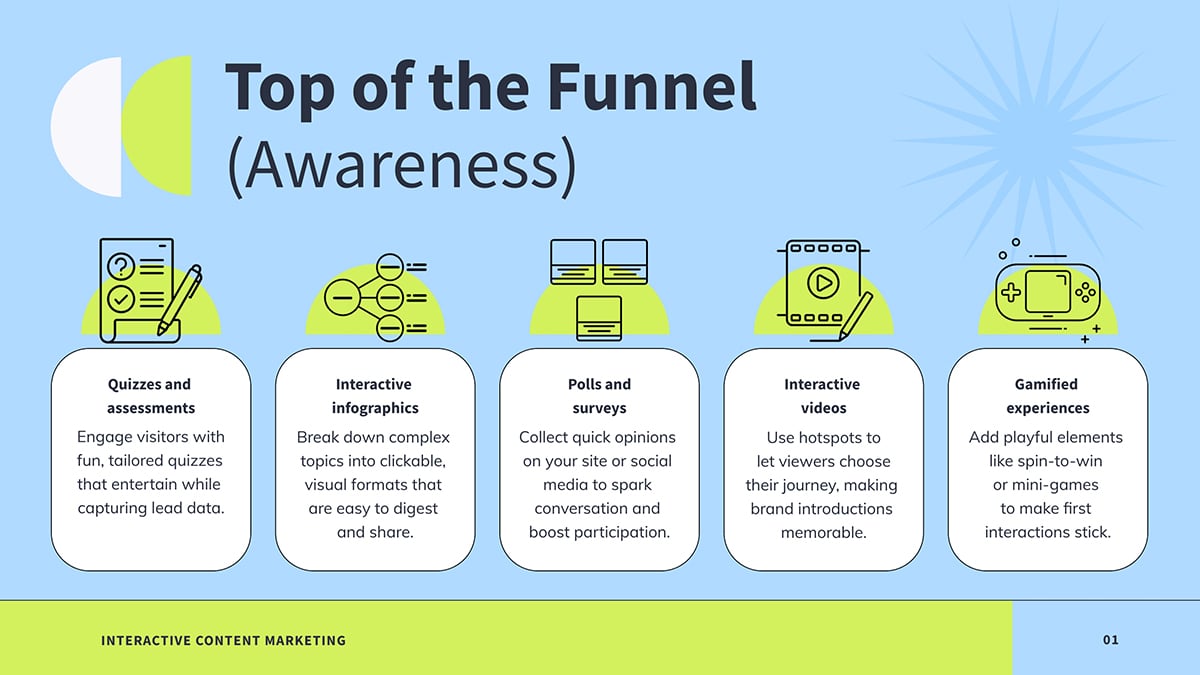
Here, prospects are evaluating options. Interactive content should build trust and prove your expertise. Here are MOFU interactive content types that work:
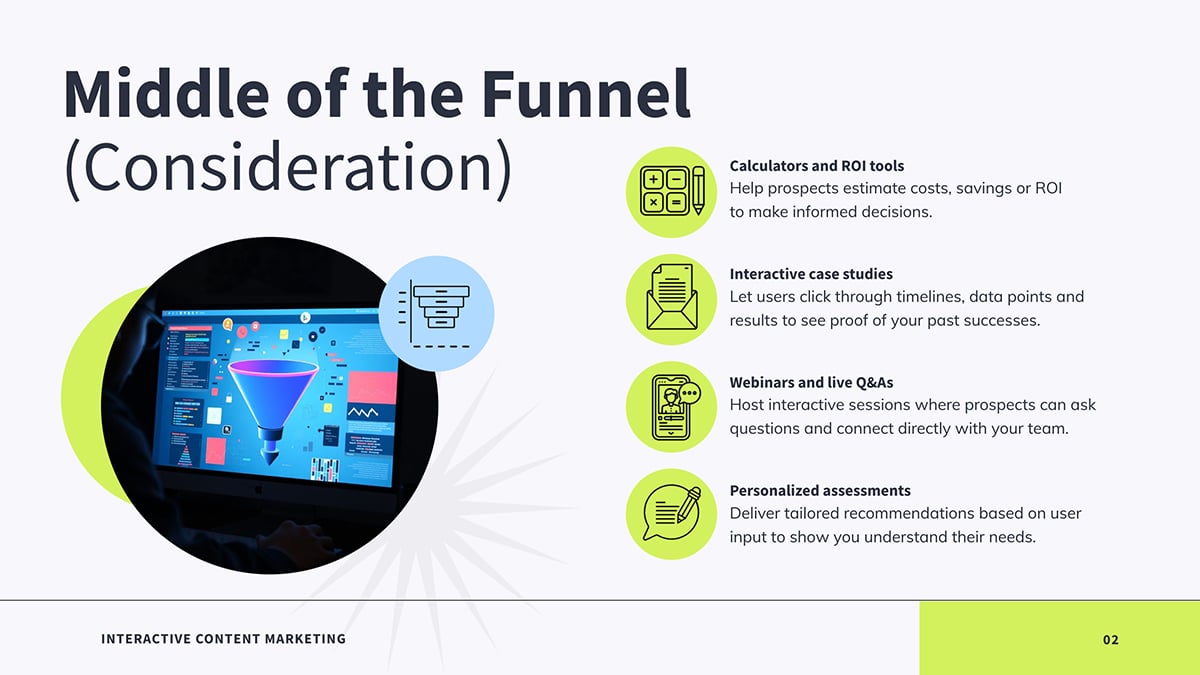
At this stage, prospects are on the brink of making a purchase. They need clarity and reassurance to choose you over competitors. Your interactive content should address lingering doubts and deliver that final “aha moment” that prompts them to take action.
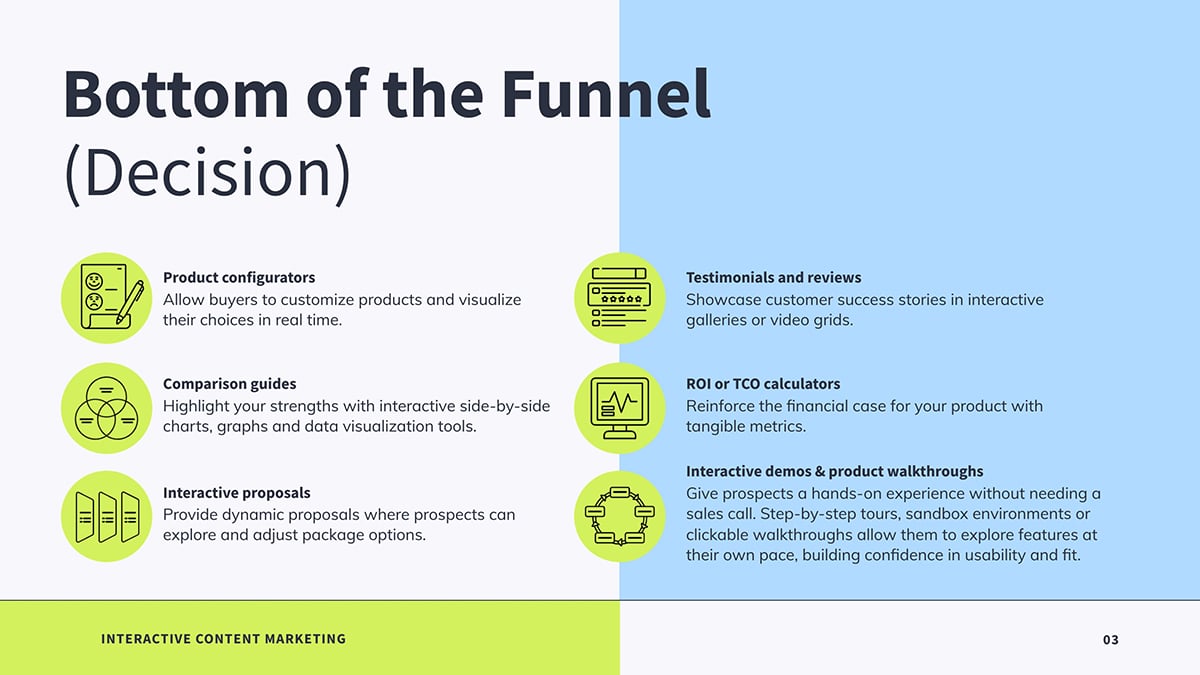
The relationship doesn’t end at purchase. It’s where loyalty is built. At the post-purchase stage, these interactive content types will get you results:
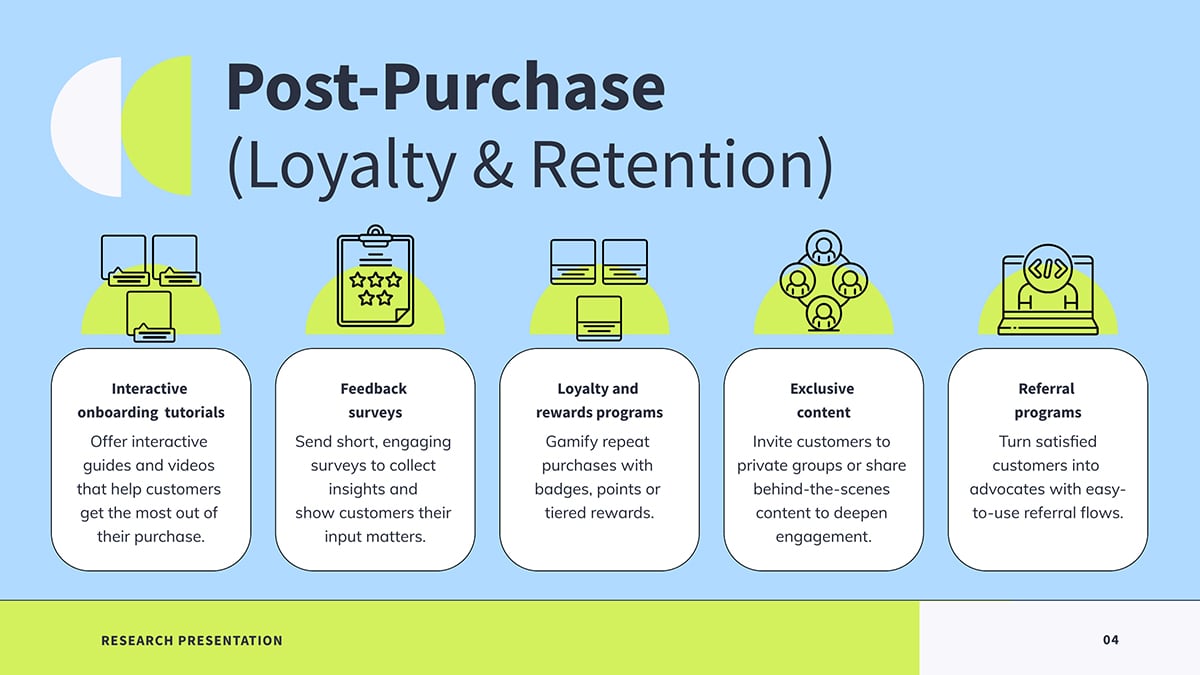
Creating interactive content is only step one.
If you stop there, you’re leaving reach, engagement and conversions on the table.
The real magic happens when you distribute it smartly across multiple channels and formats so it gets in front of the right people at the right time.
Interactive content is unique because it demands participation. That makes it naturally engaging, but it also means you can’t just post it once and hope for results. You need a plan to amplify it across your funnel and channels.
Here are distribution strategies you can start testing today.
One of the biggest wins in interactive marketing content is repurposing. If you’ve created an in-depth interactive report, don’t stop there.
Turn it into an infographic, highlight a few standout stats as social graphics or pull out a short quiz that reflects the main insights. If you’ve built a calculator, create a video walkthrough of how to use it and embed that on YouTube.
Repurposing does two things:
It extends the life of your interactive asset. And it allows you to reach people who prefer different formats. Someone might not have time to dive into a full marketing collateral but would gladly swipe through a carousel of quick highlights.
By repackaging content for multiple platforms, you create new entry points while saving production time.
For example, Salesforce repurposed a technical article on Engineering AI-Driven Recommendations into a mini 10-second video. The clip featured Sneha Singla, Director of Software Engineering at Salesforce, highlighting how her team delivers real-time personalization across platforms using both rules-based and AI-driven recommendations.
Instead of burying that story in a dense article, the video format made it instantly scannable, shareable and more appealing to busy executives.
Branding goes beyond slapping a logo in the corner. Every quiz, calculator or dashboard should scream yours, from color palette to fonts to tone of copy. This way, even if your content gets embedded on another site or shared without context, your brand stays visible.
For example, if you publish an interactive checklist, add a watermark, logo and branded design elements. If someone downloads or screenshots it, your identity still travels with it. This builds familiarity over time, which pays off when users encounter your brand again in a different channel.
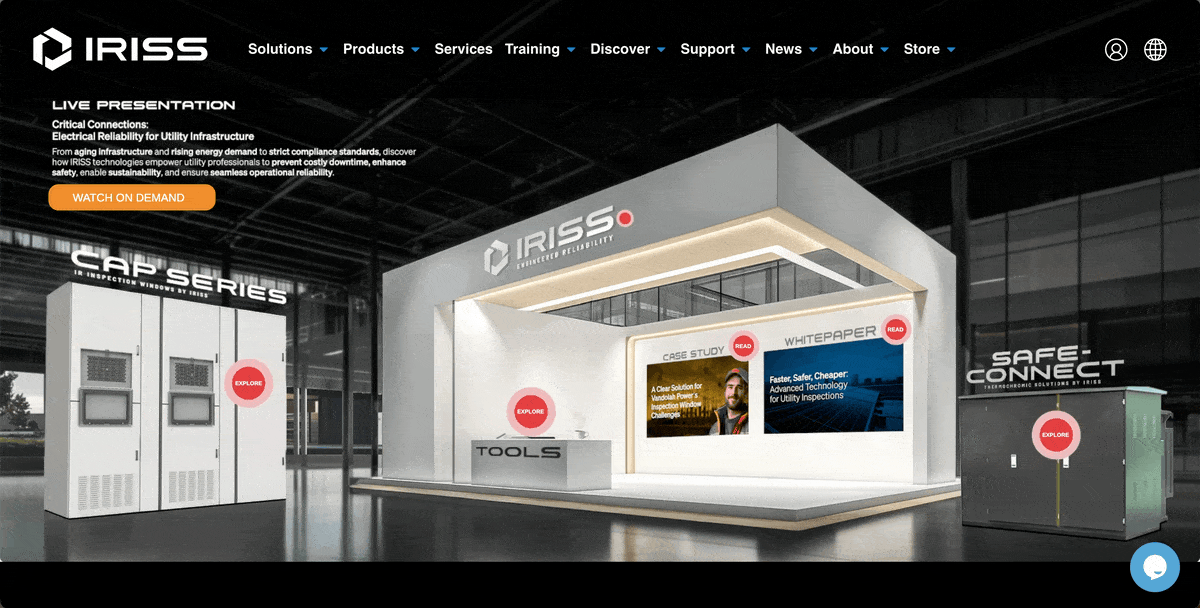
For example, IRISS built a fully branded digital showroom filled with interactive content using Visme. Visitors can explore product information, watch software demos and view upcoming event details, all in a single, self-guided experience that never loses brand consistency.

“We included an image that showcased our digital booth inside an event center, complete with our logo, clickable content, product information, white papers, industry-specific calculators, and visuals designed specifically for that audience,”- Lee Murray, Creative Content Manager, IRISS, Inc. Read the full case study.
Interactive content can rank in search results just like blogs or videos. Google often highlights calculators, tools and charts when they’re optimized with the right tags. That means your ROI calculator or interactive report could show up above a competitor’s article on the same topic.
Start with the basics. Give every interactive asset a clear title, short meta description and keyword-friendly copy. Host interactive PDFs or reports on a landing page that includes supporting text so search engines can read it. Pair each tool with a blog or short article that links to it. This strengthens SEO and gives visitors context before they dive in.
But SEO is shifting. With AI-generated summaries and chatbots answering more questions, traditional tactics alone may not bring the same traffic. Brands now need to show up where AI pulls answers by being cited as a trusted source in generated responses.
Neil Patel says SEO and GEO (AI SEO) now work side by side. Traditional SEO still drives discoverable traffic. GEO focuses on optimizing for answer-engine queries, making sure your content is visible in AI-driven search results.
The bottom line is that you need both. Optimize your resources for search today while preparing them for the way people will discover answers tomorrow.
Organic promotion is powerful. But you need a paid push. Interactive content often performs better than static ads because it sparks curiosity and encourages clicks. Think about promoting a quiz on Facebook or an interactive ebook or report on LinkedIn. The format invites action.
Here’s a LinkedIn ad that I saw at the top of my feed while I was working on this post.
Be smart with targeting. Cold audiences will respond better to light formats like quizzes or polls. Warmer audiences are more likely to engage with bottom-of-funnel tools, such as comparison charts or configurators. Match the content to where your prospect is in the journey.
Paid ads aren’t cheap. But they deliver fast results when paired with strong interactive assets. Use them to scale what’s already working in your organic channels.
Interactive content isn’t just a standalone sales enablement asset. It’s a magnet you can use to pull readers deeper into your site.
For instance, if you have an interactive blog post on budgeting, link to your financial calculator within the text. If you’re publishing an article about marketing trends, embed your interactive infographic or annual survey results.
Internal linking does two things: it boosts SEO by passing link authority across your pages, and it provides readers with immediate next steps. Instead of bouncing after one blog, they’re nudged toward a valuable resource. That means more time spent on your site, more data collected and a stronger chance of conversion.
Social media thrives on quick, engaging interactions — exactly what interactive content delivers. Quizzes, polls, carousels and mini-videos of tools in action are perfect for LinkedIn, Instagram, TikTok or X. Unlike static posts, interactive formats encourage participation, which algorithms love to amplify.
To make it work, don’t just drop a link and run. Build a spark and tease the value.
Post a quiz question in a tweet or share a short reel that shows what someone will get from completing your checklist. Better yet, invite debate using a live poll. That curiosity gap drives more clicks back to the full interactive piece.
For Spotify users, the Wrapped campaign has almost become a “cultural streaming report card”
And every December, Spotify floods social feeds with swipeable, interactive stories that highlight each user’s top artists and songs. They even provide pre-formatted story cards for Instagram and X, making sharing effortless.
This is a highly viral, personalized experience that turns individual engagement into massive reach.
B2B interactive content can work just as well. On LinkedIn, polls are an effective way to spark conversation and gather insights. Dell, for instance, created a poll asking how organizations prioritize when deploying GPU clusters at scale.
Webinars are great for thought leadership. But audience attention can drop fast. That’s where embedding interactive content makes the difference.
Adding live polls, clickable resources or even a calculator attendees can use on the spot keeps them engaged from start to finish. You can also embed a digital business card (via QR or link) into the event interface or follow‑up interactive recap, making it effortless for participants to save your contact info directly from the interactive experience.
Instead of waiting passively for a Q&A at the end, attendees can upvote questions, explore resources in real time and feel like part of the conversation.
You can also use interactive surveys before or after the event to capture data. For example, send a short pre-webinar assessment to gauge attendee knowledge. Follow that up with a personalized interactive report afterward that shows how they compare to peers. This creates a full-circle experience that’s rewarding valuable and memorable.
Your interactive content doesn’t have to live only on your site. Many industry blogs, media outlets or community hubs accept syndicated content. This might mean they embed your infographic, feature your calculator or host your checklist alongside their articles.
Syndication expands your reach into new audiences without creating new content. It also boosts backlinks, which strengthens your SEO. Look for trade publications, association websites or high-traffic blogs in your industry that would benefit from offering their readers a hands-on resource. Reach out with a tailored pitch highlighting how your interactive piece adds value to their community.
Email remains one of the highest-ROI channels for distributing interactive content. The key is not just linking to it but embedding interaction directly into the email itself. For instance, you can add a one-question poll, a mini checklist or a teaser quiz. These small touches drive higher click-through rates and keep subscribers engaged longer.
For example, check out this interactive email from McDonald’s monopoly campaign:
It features an interactive experience where users can tap a button to see who was winning the Monopoly game around the UK. The email also invites recipients to tap on the screen to play the game and win prizes.
Visme uses a similar approach in its own newsletters. They weave in short GIFs, videos and clickable elements that show users how the platform’s interactive features work in real time. Subscribers get a taste of how their features work without leaving their inbox.
Segmentation makes this even more effective. Send a detailed interactive report or ROI calculator to high-intent leads. New subscribers could get something lighter, like a quiz or a checklist. Because every interaction is trackable, you can see what engages different audience segments and feed that data back into your broader content marketing strategy.
Communities like Reddit, Quora or specialized Slack groups are full of people looking for solutions. Instead of spamming a link, craft a thoughtful response to a question and naturally include your interactive resource if it adds real value.
The beauty of forums is that posts often live for months or years, continuing to drive traffic long after you hit publish. Plus, community-driven traffic tends to be highly engaged since people are already aware of the problems and actively searching for answers.
Influencer partnerships aren’t just for fashion or beauty brands. In B2B or niche industries, collaborating with a thought leader to share your interactive content can open doors to audiences you’d never reach alone.
Imagine a recognized voice walking through your ebook in a LinkedIn post or recommending your quiz in a YouTube video. It feels more authentic because it comes from someone trusted. Micro-influencers can be especially effective here. They may have smaller audiences, but engagement is usually stronger and more targeted.
Dell Technologies teamed up with tech industry influencers to promote its Data Paradox interactive eBook.
To scale reach, they executed a multi-layered strategy:
Each influencer shared the content with their own network, giving the campaign credibility and reach among CIOs and IT leaders who mattered most.
Visitors on your website are already curious; give them a reason to stay longer. Smart CTAs and pop-ups can highlight your best interactive assets. For example, if someone is reading a blog on productivity, trigger a pop-up offering your interactive checklist for “10 Steps to Streamline Your Workflow.”
The key is relevance. Don’t interrupt with random offers; match the content to what the visitor is viewing. When CTAs feel like a natural next step instead of an interruption, people are far more likely to click through and engage.
With so many interactive content platforms out there, it can be tough to choose the right one
To help you compare, here’s a side-by-side look at the best options. Of course, we’re starting with Visme, the most versatile solution.
| Software | Key Features | Pricing | Best For | Core Uses | G2 Rating |
| Visme | Drag-and-drop editor, AI tools, interactive charts, maps, brand wizard, templates library, collaboration and workflow tools, clickable buttons, pop-ups, animations, embedded media, 3D animations & characters, interactive forms, etc. | Free plan; Paid plans from $12.25/mo | Marketers, educators, business teams | Interactive presentations, reports, infographics, documents, dashboards | 4.5/5 (450+ reviews) |
| Ceros | Advanced interactive design studio, animation controls, analytics tracking | Custom pricing | Enterprise marketers & agencies | Interactive microsites, landing pages, experiential content | 4.1/5 (50+ reviews) |
| Maglr | No-code design, storytelling templates, lead capture integrations | From $200/mo | Agencies & publishers | Digital magazines, reports, sales collateral | 4.9/5 (5 reviews) |
| Genially | Interactive templates, gamification, quiz creation | Free plan; Paid plans from $15/mo | Educators & trainers | Interactive lessons, quizzes, gamified learning | 4.7/5 (55+ reviews) |
| Outgrow | Specialized in interactive calculators, quizzes, chatbots | From $14/mo | Marketing teams | Lead generation quizzes, ROI calculators, assessments | 4.7/5 (300+ reviews) |
| Typeform | Conversational forms, surveys, quizzes, integrations | Free plan; Paid plans from $25/mo | Businesses & researchers | Surveys, feedback forms, lead gen quizzes | 4.5/5 (900+ reviews) |
| Foleon | Cloud-based editor, interactive content hub, analytics | Custom pricing | Enterprises | Digital brochures, whitepapers, interactive reports | 4.7/5 (170+ reviews) |
| ThingLink | Interactive media editor, image & video hotspots, VR/AR support | Free plan; Paid plans from $29/mo | Educators, e-learning teams, publishers | Interactive images, 360° tours, training modules | 4.1/5 (10+ reviews) |
| Interacty | Templates for quizzes, games and interactive tasks; leaderboard features | Free plan; Paid plans from $14/mo | Teachers, marketers, nonprofits | Gamified quizzes, competitions, educational interactives | 4.6/5 (40+ reviews) |
| Shorthand | Visual storytelling platform, immersive layouts, no-code editor | From $40/mo (billed annually) | Publishers, nonprofits, enterprises | Interactive stories, reports, long-form articles | 4.7/5 (100+ reviews) |
| Mapme | Map builder with interactive layers, filters and multimedia embeds | From $30/mo | Tourism boards, real estate, event organizers | Interactive maps, local guides, directories | 4.0/5 (10+ reviews) |
| Storylane | No-code demo builder, step-by-step guides, interactive product tours | Free plan; Paid plans from $40/month billed annually | SaaS companies & product marketers | Interactive product demos, customer onboarding | 4.8/5 (840+ reviews) |
| Tiled (tiled.co) | Microapp builder, interactive sales content, analytics | Custom pricing | Sales & marketing teams | Interactive brochures, sales decks, playbooks | 4.2/5 (200+ reviews) |
Building interactive content that converts isn’t as simple as adding a quiz to your website or throwing an animation into a report.
It requires intent, storytelling and execution that ties every click to business outcomes.
Here’s how to create interactive content that drives results.
Interactive content can be a conversion powerhouse.
Demand Metric found it drives conversions 70% of the time, compared to just 36% for static content.
But you can only achieve these results if every interactive asset is tied back to a specific conversion goal.
If the goal is lead capture, your interactive should guide users toward sharing details. If it’s pipeline acceleration, it should help prospects self-qualify or shorten evaluation cycles.
Think of an interactive report or ebook. On the surface, they’re great because of the engaging reading experiences.
But built right, it’s also a lead gen tool and potential conversion engine. Start by identifying the inputs that matter most to your sales team.
Structure the tool so users see valuable results instantly, but gate deeper insights behind a simple form (“Send my full report to email”). This turns visitors into qualified leads while still delivering immediate value.
One of the easiest traps in interactivity is “gimmick content” (creating something “fun” without a clear purpose). A flashy game might grab attention, but unless it aligns with intent, it won’t convert.
The smarter move is mapping your interactive to the stage of the buyer’s journey. (We’ve already discussed this in detail.)
At the awareness stage, someone might want quick insights (“Which marketing channel suits me best?”). In the consideration stage, they may want detailed validation (“How much ROI could I see from this tool?”).
Don’t just brainstorm formats; start by mapping customer questions. Pull actual queries from sales calls, search console data or customer success tickets. Match these insights to the journey stage. Then serve interactive content in the format that answers them best.
Kristina Barron, photographer and experiential marketer, nails this approach:
I often create interactive experiences at events through photo booths that allow guests to instantly see, print, or share their photos. I think this type of engagement adds real value to the event, because it's not just a service, it becomes part of the entertainment."
A marketer exploring trends will engage with an interactive infographic. But a CFO asking “What’s the payback period?” doesn’t need a personality quiz. They need a financial calculator or an interactive ROI chart.
The most effective interactive experiences tell a story in chapters. Instead of overwhelming users with information, they pace it out, building curiosity with each click. According to Demand Gen Report, 91% of buyers prefer content that’s easy to consume and guides them through a narrative.
Instead of dumping all information at once, use clickable tabs, pop-ups and animations to reveal content gradually.
Think of an interactive annual report.
Instead of a 50-page PDF, break it into sections that unfold step by step: a striking headline stat, followed by clickable icons and stock photos that reveal deeper insights and pop-ups with case studies or videos.

Source: Visme
The storytelling arc keeps users moving forward, while the interactivity makes the content stick. To build this, sketch your narrative beats first (Problem → Insight → Solution → Proof), then layer in clickable elements that reveal each beat at the right moment.
One of the biggest missed opportunities with interactive content is data. Every click, answer or selection is a data point. But if you gate everything behind a form, you’ll lose people.
The best approach is progressive disclosure. Give value upfront, then ask for small pieces of information in context.
For example, instead of asking for an email upfront, let the user finish a quiz and see a high-level summary. Then, offer a detailed report (personalized with benchmarks) in exchange for their contact info. This feels like a natural next step, not a hurdle.
For checklists, let users tick tasks in real time, but gate a “Save my progress” option that requires sign-up.This balance between value and data capture keeps friction low while still building a rich dataset.
According to Statista, over 60% of content consumption happens on mobile.
If your interactive breaks on a phone, it’s dead on arrival.
Test everything on mobile before launch. Does the calculator resize correctly? Do the buttons respond to touch? Are animations smooth or do they drag load times?
Speed and performance matter just as much. A Portent study found that a B2B site loading in 1 second has a conversion rate three times higher than one that loads in 5 seconds. Compress videos, use lightweight scripts and keep your design modular.
If an animation looks cool on desktop but crashes on mobile, cut it. Interactivity should speed up decision-making, not slow it down.
The true power of interactive content is delivering personalized results. Static reports can’t do that, but quizzes, calculators and assessments can. People are more likely to act when they feel the output speaks directly to them.
In one Accenture survey, 91% of consumers said they’re more likely to shop with brands that provide personalized offers and recommendations.
For example, Deloitte’s interactive “Business Chemistry” assessment gives users one of four distinct personality profiles, accompanied by custom advice.

The result? Millions of shares and a perception of Deloitte as a trusted advisor, not just a consultancy.
HubSpot’s Website Grader is another excellent example. Users input their site URL and in seconds, they get a custom score with specific tips to improve.


The grading itself is valuable, but the brilliance lies in the tailored follow-up: “Want to fix these issues? Here’s how HubSpot can help.”
You don’t need Deloitte or HubSpot's budget to set up these interactive content ideas. Even little things like relevant or personalized suggestions in a product quiz can lift conversions.
Too many teams launch interactive content and walk away. That’s a missed opportunity.
Treat each asset like a live campaign: track completion rates, drop-off points and conversions. Which quiz questions make people drop off? Which sections of your interactive report get the most clicks? These signals show where to double down or make adjustments.
A/B test different layouts, CTA placements and even output styles. These changes may look insignificant but they pack a big punch. Unbounce found that changing a single word in a CTA button increased conversions by 90%.
With interactive content, the impact can be even bigger because users are already invested in the flow. Sometimes changing the wording of a results page CTA (“Get my personalized plan” vs. “See recommendations”) can dramatically lift conversion rates.
An interactive report that doesn’t feed into your CRM is a wasted opportunity. To drive conversions, every tool should connect to your funnel.
Link forms and responses directly to your marketing automation. Sync data into Salesforce or HubSpot. Trigger nurture campaigns that follow up based on user behavior.
For example, if a prospect completes your ROI calculator and inputs “100+ employees,” you can automatically route them to enterprise sales outreach. If they score low on a quiz, push them into an educational nurture track. The goal is to turn clicks into context and context into a pipeline.
Without funnel integration, interactive content risks becoming a vanity metric exercise instead of a conversion driver.
When you treat every click as part of the buyer’s journey, you transform interactivity from a shiny object into a scalable growth engine.
Interactive content marketing drives engagement. But that alone doesn’t justify the allocation.
To make a case for more investments and scale your campaigns, you need to show how it lifts lead quality, accelerates pipeline velocity and drives revenue.
The foundation of ROI measurement is clarity. Before you build a quiz, report or calculator, decide what success looks like. Are you trying to capture more qualified leads? Accelerate decision-making for sales? Drive upsells or renewals? Each goal has a different metric.
For example, an interactive product presentation at the bottom of the funnel should be measured on demo requests and closed deals influenced, not on traffic.
By contrast, an interactive infographic at the top of the funnel may be judged on new contacts acquired or content downloads. Tying each piece to a stage of the funnel prevents you from drowning in irrelevant data.
Clicks are table stakes. With interactive content, you need to measure much richer signals like completion rates, time on task, drop-off points and repeat interactions.
These metrics tell you whether your audience is just browsing or genuinely engaged. And you only get the lift in conversion rate if people complete the experience.
Set up event tracking for every action: which quiz questions are answered, which report sections gets read, which videos are played to completion. The deeper the engagement, the more predictive it is of purchase intent. If your completion rates are low, that’s a sign to refine the design or narrative.
Volume is nice, but quality drives ROI. Interactive tools give you unique data points you can use for lead scoring — quiz answers, benchmark comparisons or selections in a configurator. Compare the downstream performance of leads captured via interactive content versus those from static ebooks or ads.
For example, if leads from your calculator convert at 18% versus 7% from static forms, you’ve got a clear case for ROI. You should also calculate cost per lead (CPL). Divide the total cost of producing and promoting the interactive asset by the number of qualified leads it generated. If your CPL is lower than other channels, you’ve proven efficiency as well as impact.
Executives want to see the impact on the pipeline, not just engagement. That means you need to connect interactive touchpoints directly to deals.
Use CRM attribution to answer questions like: Did prospects who engaged with an interactive case study or comparison guide progress faster to opportunity? Did customers who explored an interactive ROI dashboard or product walkthrough close with higher deal values?
When you build interactive content with Visme, you can dig into our analytics tools to see who viewed your content, how long they spent on each section and where they clicked. These insights don’t just measure activity. They give your sales teams actionable signals to prioritize follow-ups with the most engaged prospects.

There’s more to measuring ROI than net-new pipeline. I know from experience that the impact of interactive content isn’t always immediate.
Often, its biggest value shows up in retention, upsells and customer lifetime value (CLV). Interactive onboarding tools, tutorials or loyalty games can reduce churn by helping customers succeed faster and stay engaged longer.
Let’s say an interactive onboarding checklist cuts time-to-value for new users from 30 days to 14. You can quantify the ROI in lower support costs, faster product adoption and higher renewal rates.
Measure adoption, feature usage and upsell success among customers who engage with interactive assets versus those who don’t. The data may show that interactivity pays off long after the first conversion.
Interactive content marketing is a strategy that uses interactive elements like polls, quizzes, calculators, data visualizations, maps, interactive infographics, animations or even social conversations to turn passive audiences into active participants.
Interactive content works because it makes the reader’s experience more immersive and engaging. Rather than just reading or scrolling, users click, tap, swipe or explore. This sense of participation creates a psychological investment, which makes the content memorable.
Interactive content also keeps people engaged for longer, which means lower bounce rates and a deeper connection with the audience. It also gives marketers richer data about preferences and behavior, which can be used to personalize follow-ups and improve future campaigns. That’s why more businesses are making interactive content a cornerstone of their marketing strategy.
Linear content is content that follows a fixed path from start to finish. The creator controls the order, pacing and flow. Examples include blog posts, eBooks, whitepapers or videos you simply watch from beginning to end. The user is passive; they can read, scroll or watch, but they can’t change the experience or influence what comes next.
Interactive content, on the other hand, puts the user in control. They can click, tap, answer questions, navigate sections or explore information at their own pace. This creates a two-way experience. Examples include quizzes, ROI calculators, clickable infographics, product configurators and interactive videos where users choose what to watch next.
Interactive content marketing is one of the smartest ways to breathe life into traditional campaigns. It not only tears down the wall between you and your customers and prospects but also creates memorable experiences.
You can rely on this format to connect, educate and guide people toward the next step.
And it doesn’t have to be complicated. Even simple touches like hover effects, clickable pop-ups or animated elements can turn a static piece of content into an experience.
When you’re ready to go bigger, you can create immersive formats like interactive dashboards, quizzes or even AR-style experiences that let prospects explore your brand story on their own terms.
With Visme, you can make this shift quickly, no coding required. Build interactive reports with clickable sections, add pop-ups to presentations, design quizzes and forms to collect data and layer animations to keep your audience engaged from start to finish.
Create an account with Visme and access all the tools you need to make every piece of content more dynamic, interactive and memorable.
Design visual brand experiences for your business whether you are a seasoned designer or a total novice.
Try Visme for free